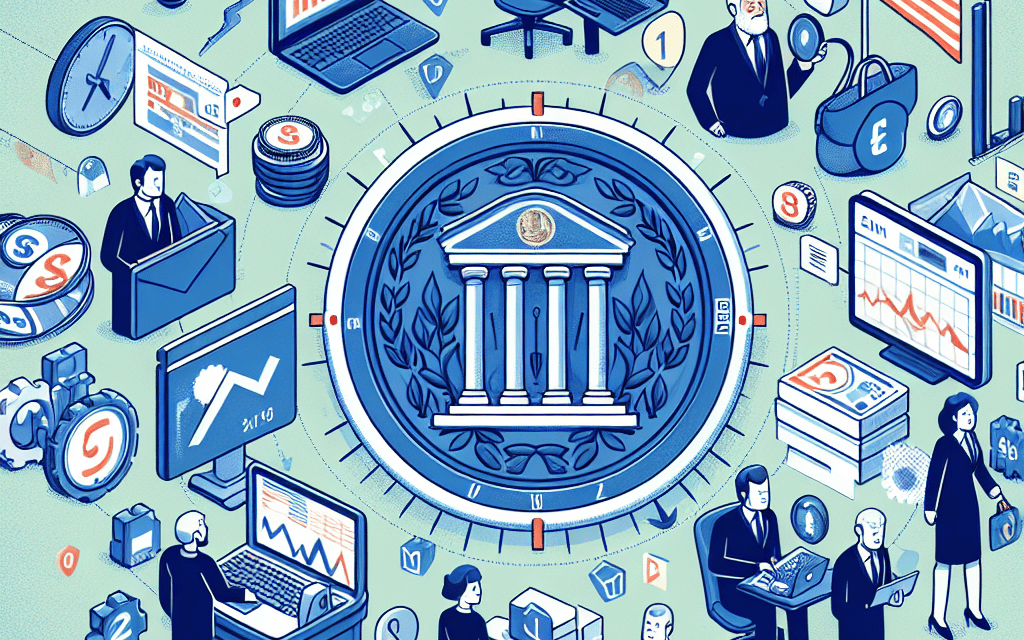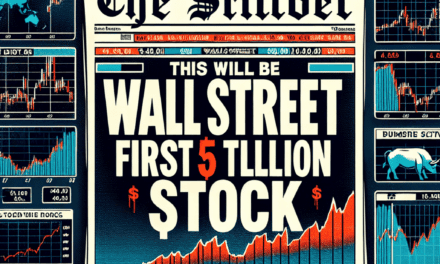“Decisive Moments: Election Outcomes and Fed Decisions Shape Market Futures”
Introduction
This week is pivotal for global markets as two major events unfold: the presidential election and the Federal Reserve meeting. Investors and analysts are closely monitoring these developments, as their outcomes are expected to significantly influence economic policies and market dynamics. The presidential election could reshape fiscal strategies and regulatory frameworks, while the Federal Reserve’s decisions on interest rates and monetary policy will be crucial in guiding economic recovery and managing inflation. Together, these events are set to create a volatile environment, with potential implications for equities, bonds, and currencies worldwide.
Analysis Of The Presidential Election’s Influence On Stock Market Volatility
This week has been pivotal for financial markets, as two major events have captured the attention of investors and analysts alike: the presidential election and the Federal Reserve meeting. Both events have significant implications for market volatility, particularly in the stock market, which often reacts sensitively to political and economic developments. Understanding the influence of the presidential election on stock market volatility requires a nuanced analysis of historical trends, investor sentiment, and the potential policy shifts that accompany a change in administration.
Historically, presidential elections have been associated with increased market volatility. This is largely due to the uncertainty surrounding potential policy changes that could impact various sectors of the economy. Investors tend to react to the perceived economic policies of the candidates, which can lead to fluctuations in stock prices. For instance, a candidate favoring increased regulation might cause concern in industries such as finance and energy, while a candidate advocating for tax cuts could boost investor confidence in consumer-driven sectors. Consequently, the stock market often experiences heightened volatility in the weeks leading up to and following an election, as investors adjust their portfolios in anticipation of the election outcome.
Moreover, the current election cycle has been particularly contentious, with significant implications for both domestic and international economic policies. This has further amplified market volatility, as investors grapple with the potential for shifts in trade policies, tax regulations, and government spending. The uncertainty surrounding these issues can lead to rapid changes in market sentiment, as investors seek to position themselves advantageously in response to the evolving political landscape. Additionally, the role of media coverage and public opinion cannot be underestimated, as they contribute to shaping investor perceptions and, consequently, market movements.
In tandem with the presidential election, the Federal Reserve meeting this week has also played a crucial role in influencing market dynamics. The Fed’s decisions regarding interest rates and monetary policy are closely watched by investors, as they have direct implications for economic growth and inflation. In times of political uncertainty, the Fed’s actions can either exacerbate or mitigate market volatility. For instance, a decision to maintain low interest rates might be seen as supportive of economic growth, thereby calming investor nerves and stabilizing the stock market. Conversely, any indication of tightening monetary policy could heighten concerns about economic slowdown, leading to increased market turbulence.
The interplay between the presidential election and the Fed meeting highlights the complex nature of market volatility. While political events can create uncertainty and drive short-term fluctuations, the underlying economic fundamentals, as influenced by the Fed’s policies, ultimately play a critical role in shaping long-term market trends. Investors must therefore navigate this intricate landscape by balancing their reactions to immediate political developments with a broader understanding of economic indicators and monetary policy.
In conclusion, this week’s presidential election and Federal Reserve meeting have underscored the intricate relationship between political events and stock market volatility. As investors continue to assess the implications of these events, it is essential to maintain a balanced perspective that considers both the immediate impact of political developments and the longer-term influence of economic policies. By doing so, investors can better navigate the complexities of the financial markets and make informed decisions that align with their investment objectives.
How The Federal Reserve Meeting Could Shape Economic Policy
This week, the intersection of political and economic events has captured the attention of investors and policymakers alike, as the presidential election and the Federal Reserve meeting converge to potentially reshape the economic landscape. The Federal Reserve’s meeting, in particular, holds significant implications for future economic policy, as it comes at a time when the global economy is navigating through a complex web of challenges, including inflationary pressures, supply chain disruptions, and geopolitical tensions. As such, the decisions made by the Federal Reserve could have far-reaching consequences, influencing not only domestic economic conditions but also global financial markets.
To begin with, the Federal Reserve’s primary focus remains on managing inflation and ensuring economic stability. In recent months, inflation has surged to levels not seen in decades, prompting concerns about the purchasing power of consumers and the overall health of the economy. The Federal Reserve, therefore, faces the delicate task of balancing the need to curb inflation with the desire to support economic growth. This balancing act is further complicated by the ongoing recovery from the COVID-19 pandemic, which has left certain sectors of the economy more vulnerable than others. Consequently, the Federal Reserve’s policy decisions will need to be carefully calibrated to address these multifaceted challenges.
Moreover, the Federal Reserve’s approach to interest rates will be closely scrutinized during this meeting. Interest rates are a critical tool in the Federal Reserve’s arsenal, as they influence borrowing costs for consumers and businesses, thereby affecting spending and investment decisions. A decision to raise interest rates could signal the Federal Reserve’s commitment to tackling inflation, but it also risks slowing down economic growth by making borrowing more expensive. Conversely, maintaining low interest rates could support continued economic expansion but might exacerbate inflationary pressures. Thus, the Federal Reserve’s guidance on interest rates will be pivotal in shaping market expectations and investor sentiment.
In addition to interest rates, the Federal Reserve’s stance on its asset purchase program will also be a key area of focus. Since the onset of the pandemic, the Federal Reserve has engaged in large-scale asset purchases to inject liquidity into the financial system and support economic activity. However, as the economy shows signs of recovery, there is growing debate about the appropriate timing and pace of tapering these purchases. A decision to reduce asset purchases could be interpreted as a vote of confidence in the economy’s resilience, but it also carries the risk of unsettling financial markets that have become accustomed to the central bank’s accommodative stance.
Furthermore, the Federal Reserve’s meeting takes place against the backdrop of the presidential election, which adds an additional layer of complexity to the economic outlook. The outcome of the election could influence fiscal policy, regulatory changes, and international relations, all of which have implications for economic growth and stability. As such, the Federal Reserve will need to consider the potential impact of political developments on its policy decisions, while maintaining its independence and commitment to its dual mandate of promoting maximum employment and stable prices.
In conclusion, the Federal Reserve meeting this week is poised to play a crucial role in shaping economic policy amid a confluence of challenges and uncertainties. The decisions made by the Federal Reserve will not only affect the trajectory of the U.S. economy but also reverberate across global financial markets. As investors and policymakers await the outcomes of this pivotal meeting, the focus will remain on how the Federal Reserve navigates the complex interplay of inflation, interest rates, asset purchases, and political developments to chart a course for sustainable economic growth.
Comparing Historical Market Reactions To Presidential Elections
In examining the historical market reactions to presidential elections, it is essential to consider the multifaceted nature of these events and their profound impact on financial markets. Presidential elections, by their very nature, introduce a degree of uncertainty that can lead to volatility in the markets. Investors, analysts, and policymakers closely scrutinize these events, as the outcome can significantly influence economic policies, regulatory environments, and international relations. Consequently, understanding historical market reactions provides valuable insights into potential future trends.
Historically, U.S. presidential elections have often led to increased market volatility in the short term. This volatility is primarily driven by the uncertainty surrounding potential policy changes that a new administration might implement. For instance, during the 2000 presidential election, the prolonged uncertainty due to the contested results between George W. Bush and Al Gore led to a notable decline in market confidence. The S&P 500 experienced significant fluctuations as investors grappled with the uncertainty of the election outcome and its implications for economic policy.
Moreover, the market’s reaction is not solely dependent on the election’s outcome but also on the perceived economic policies of the candidates. For example, the 2016 election of Donald Trump saw an initial market dip due to the unexpected result. However, markets quickly rebounded as investors anticipated pro-business policies, such as tax cuts and deregulation, which were expected to stimulate economic growth. This reaction underscores the importance of investor sentiment and expectations in shaping market responses to electoral outcomes.
In addition to the immediate aftermath of elections, the long-term market impact is often influenced by the policies enacted by the incoming administration. Historical data suggests that markets tend to perform well under administrations that prioritize economic growth and stability. For instance, the economic policies implemented during the Reagan administration in the 1980s, which focused on tax cuts and deregulation, were associated with a prolonged bull market. Conversely, administrations that face economic challenges or implement policies perceived as unfavorable to business interests may experience more subdued market performance.
Transitioning to the present week, the intersection of the presidential election and the Federal Reserve meeting adds another layer of complexity to market dynamics. The Federal Reserve’s decisions on interest rates and monetary policy are critical factors that influence market behavior. Historically, the Fed has often refrained from making significant policy changes close to an election to avoid appearing politically motivated. However, in times of economic uncertainty, such as during the 2008 financial crisis, the Fed has taken decisive action regardless of the electoral calendar.
This week, investors are keenly observing both the election and the Fed meeting for signals that could impact market trajectories. The Fed’s stance on interest rates, in particular, is a focal point, as it directly affects borrowing costs, consumer spending, and business investment. Any indication of a shift in monetary policy could lead to significant market movements, especially in conjunction with the election results.
In conclusion, while historical market reactions to presidential elections provide a framework for understanding potential outcomes, each election cycle presents unique challenges and opportunities. The interplay between electoral outcomes and Federal Reserve actions further complicates the landscape, making it imperative for investors to remain vigilant and adaptable. As this week unfolds, the confluence of these key events will undoubtedly shape market sentiment and influence investment strategies in the months to come.
The Role Of Interest Rates In Market Movements Post-Fed Meeting

In the wake of this week’s pivotal events, the interplay between the presidential election and the Federal Reserve’s meeting has captured the attention of market participants worldwide. Central to these discussions is the role of interest rates, which serve as a critical lever in influencing market movements. As the Federal Reserve convened to deliberate on monetary policy, investors keenly anticipated any signals regarding interest rate adjustments, understanding that such decisions could have profound implications for financial markets.
Interest rates, set by the Federal Reserve, are a fundamental tool used to manage economic stability. They influence borrowing costs, consumer spending, and business investment, thereby affecting overall economic growth. In the context of the recent Fed meeting, the central bank’s stance on interest rates was particularly significant given the current economic climate. With inflationary pressures persisting and economic recovery still uneven, the Fed’s decision-making process was under intense scrutiny. Market participants were eager to discern whether the Fed would maintain its current rate policy or signal a shift in response to evolving economic conditions.
The relationship between interest rates and market movements is intricate. When the Federal Reserve opts to raise interest rates, borrowing costs increase, which can dampen consumer spending and business investment. This often leads to a cooling effect on economic activity, which can be reflected in stock market performance. Conversely, when the Fed lowers interest rates, it typically stimulates economic activity by making borrowing cheaper, encouraging spending and investment. This can lead to a boost in stock prices as investors anticipate stronger corporate earnings and economic growth.
Following the Fed meeting, the central bank’s decision to hold interest rates steady was met with a mixed reaction from the markets. On one hand, the decision provided a sense of stability, as it suggested that the Fed was not overly concerned about runaway inflation. On the other hand, some investors expressed concern that maintaining current rates might not be sufficient to address underlying economic challenges. This ambivalence was reflected in market volatility, as traders weighed the potential long-term impacts of the Fed’s policy stance.
Moreover, the timing of the Fed meeting coincided with the presidential election, adding another layer of complexity to market dynamics. The outcome of the election has significant implications for fiscal policy, regulatory changes, and international trade relations, all of which can influence market sentiment. As investors processed the election results alongside the Fed’s interest rate decision, they were tasked with navigating a landscape marked by uncertainty and potential policy shifts.
In conclusion, the role of interest rates in market movements post-Fed meeting cannot be overstated. As a key determinant of economic activity, interest rates influence investor behavior and market trends. The Federal Reserve’s decision to maintain its current rate policy reflects a cautious approach amid a complex economic environment. However, the interplay between this decision and the broader political context underscores the multifaceted nature of market dynamics. As investors continue to assess the implications of this week’s events, the ongoing dialogue between monetary policy and market movements will remain a focal point for understanding future economic trajectories.
Investor Sentiment: Navigating Uncertainty During Election Week
This week, investor sentiment is being closely monitored as two significant events unfold: the presidential election and the Federal Reserve meeting. Both events are pivotal, with the potential to influence market dynamics substantially. As investors navigate this period of uncertainty, understanding the implications of these events is crucial for making informed decisions.
The presidential election, a cornerstone of democratic processes, invariably brings a degree of uncertainty to financial markets. Historically, markets have shown volatility in the lead-up to and aftermath of elections, as investors attempt to anticipate the economic policies of the incoming administration. This year is no exception, with market participants keenly observing the electoral developments. The outcome could lead to shifts in fiscal policy, regulatory changes, and international trade relations, all of which have direct implications for market performance. Investors are particularly focused on sectors that may be affected by policy changes, such as healthcare, energy, and technology. Consequently, the election results could prompt a reallocation of assets as investors adjust their portfolios to align with the anticipated policy landscape.
Simultaneously, the Federal Reserve meeting is another focal point for investors this week. The Fed’s decisions on interest rates and monetary policy are critical in shaping economic conditions. In recent months, the Fed has maintained a dovish stance, aiming to support economic recovery amid lingering uncertainties. However, with inflationary pressures persisting, there is speculation about potential shifts in policy. Investors are eager to glean insights from the Fed’s statements regarding future interest rate hikes and tapering of asset purchases. Any indication of a change in the Fed’s approach could have immediate repercussions on bond yields, equity markets, and currency valuations.
The interplay between the election and the Fed meeting adds an additional layer of complexity to the investment landscape. While the election outcome will influence fiscal policy, the Fed’s actions will determine the monetary environment. Investors must consider how these two forces will interact and impact economic growth, inflation, and market stability. For instance, a government inclined towards increased spending could stimulate economic growth, but if coupled with a tightening monetary policy, it might lead to higher borrowing costs and dampen investment.
In navigating this uncertainty, investors are advised to adopt a balanced approach. Diversification remains a key strategy, allowing investors to mitigate risks associated with specific sectors or asset classes. Additionally, maintaining a long-term perspective can help investors weather short-term volatility. It is also prudent for investors to stay informed about policy developments and economic indicators, enabling them to make timely adjustments to their portfolios.
Moreover, investor sentiment is not solely driven by domestic events. Global factors, such as geopolitical tensions and international economic trends, continue to play a significant role in shaping market dynamics. Therefore, a comprehensive understanding of both domestic and international factors is essential for investors seeking to navigate this complex environment.
In conclusion, this week presents a challenging yet potentially rewarding landscape for investors. The presidential election and the Federal Reserve meeting are key events that will shape market sentiment and influence investment decisions. By staying informed and adopting a strategic approach, investors can effectively manage uncertainty and position themselves for future opportunities. As the week unfolds, the ability to adapt to changing circumstances will be crucial in navigating the evolving market landscape.
Key Takeaways From The Fed’s Latest Economic Projections
This week has been pivotal for both political and economic landscapes, with the presidential election and the Federal Reserve meeting taking center stage. The intersection of these events has had a profound impact on financial markets, as investors and analysts alike seek to understand the implications of the Federal Reserve’s latest economic projections. As the dust begins to settle, it is crucial to examine the key takeaways from the Fed’s recent announcements and how they might influence market dynamics moving forward.
To begin with, the Federal Reserve’s economic projections have provided a clearer picture of the central bank’s outlook on growth, inflation, and unemployment. The Fed has maintained its commitment to fostering maximum employment and price stability, reiterating its stance on keeping interest rates at historically low levels for the foreseeable future. This decision underscores the Fed’s cautious approach in navigating the post-pandemic recovery, as it aims to support economic growth while keeping inflationary pressures in check.
Moreover, the Fed’s projections indicate a more optimistic view of economic growth compared to previous forecasts. This upward revision is largely attributed to stronger-than-expected consumer spending and robust business investments, which have bolstered economic activity. However, the Fed has also acknowledged potential headwinds, such as geopolitical tensions and supply chain disruptions, which could pose risks to sustained growth. Consequently, the central bank has emphasized the importance of remaining vigilant and adaptable in its policy approach.
In terms of inflation, the Fed’s projections suggest that price increases may be more persistent than initially anticipated. While the central bank continues to describe the current inflationary pressures as “transitory,” it has also signaled a willingness to adjust its policy stance should inflation remain elevated for an extended period. This nuanced position reflects the Fed’s balancing act between supporting economic recovery and preventing runaway inflation, a challenge that has been further complicated by the ongoing global supply chain issues.
Turning to the labor market, the Fed’s outlook remains cautiously optimistic. The central bank has noted significant improvements in employment figures, yet it recognizes that the recovery is uneven across different sectors and demographic groups. The Fed’s commitment to achieving maximum employment suggests that it will continue to prioritize policies that support job creation and workforce participation. This focus on inclusivity is particularly important as the economy transitions from pandemic-induced disruptions to a more stable growth trajectory.
The interplay between the Fed’s economic projections and the presidential election has also been a focal point for market participants. The election outcome is expected to influence fiscal policy, regulatory changes, and international relations, all of which have direct implications for economic performance. As such, investors are closely monitoring how the new administration’s policies align with the Fed’s projections and what this means for future monetary policy decisions.
In conclusion, the Federal Reserve’s latest economic projections have provided valuable insights into the central bank’s assessment of the current economic landscape and its policy priorities. While the Fed remains committed to supporting growth and employment, it is also prepared to address inflationary pressures should they persist. As the markets digest these projections alongside the results of the presidential election, the coming weeks will be critical in shaping expectations for economic policy and market performance. The interplay of these factors will undoubtedly continue to influence investor sentiment and market dynamics in the near term.
Strategies For Investors Amidst Political And Economic Uncertainty
In a week marked by significant political and economic developments, investors are navigating a landscape fraught with uncertainty. The presidential election, a pivotal event that invariably influences market dynamics, has captured the attention of stakeholders worldwide. Simultaneously, the Federal Reserve’s meeting, with its potential to reshape monetary policy, adds another layer of complexity to the investment environment. As these events unfold, investors are seeking strategies to mitigate risks and capitalize on opportunities, underscoring the importance of a well-considered approach in times of volatility.
The presidential election, a cornerstone of democratic processes, often serves as a barometer for market sentiment. Historically, elections have been associated with heightened volatility, as investors grapple with the implications of potential policy shifts. This year is no exception, with market participants closely monitoring the candidates’ platforms on taxation, regulation, and fiscal policy. The outcome of the election could herald significant changes in these areas, influencing sectors such as healthcare, energy, and technology. Consequently, investors are advised to remain vigilant, assessing how different scenarios might impact their portfolios.
In parallel, the Federal Reserve’s meeting this week is poised to play a crucial role in shaping economic expectations. The Fed’s decisions on interest rates and monetary policy are pivotal, as they directly affect borrowing costs, consumer spending, and business investment. With inflationary pressures persisting, the central bank faces the delicate task of balancing economic growth with price stability. Investors are keenly aware that any indication of a shift in the Fed’s stance could trigger market reactions, necessitating a proactive approach to portfolio management.
Given these intertwined political and economic factors, investors are encouraged to adopt strategies that emphasize diversification and risk management. Diversification, a fundamental principle of investing, can help mitigate the impact of adverse developments in any single sector or asset class. By spreading investments across a broad range of assets, investors can reduce their exposure to specific risks while maintaining the potential for returns. Additionally, incorporating alternative investments, such as commodities or real estate, may provide a hedge against market volatility.
Moreover, maintaining a long-term perspective is crucial in navigating periods of uncertainty. While short-term market fluctuations can be unsettling, history has shown that markets tend to recover over time. Investors who remain focused on their long-term goals, rather than reacting impulsively to immediate events, are more likely to achieve favorable outcomes. This approach requires discipline and patience, as well as a commitment to regular portfolio reviews to ensure alignment with evolving market conditions.
In conclusion, the convergence of the presidential election and the Federal Reserve’s meeting this week presents both challenges and opportunities for investors. By staying informed and adopting strategies that prioritize diversification, risk management, and a long-term outlook, investors can better position themselves to navigate the complexities of the current environment. As political and economic landscapes continue to evolve, the ability to adapt and respond thoughtfully will be key to achieving investment success amidst uncertainty.
Q&A
1. **What is the significance of the presidential election this week?**
– The presidential election is significant as it can influence economic policies, regulatory changes, and international relations, all of which can impact market sentiment and investor confidence.
2. **How might the election results affect the stock market?**
– Election results can lead to market volatility as investors react to potential policy shifts. A clear winner may stabilize markets, while a contested result could increase uncertainty and volatility.
3. **What is the Federal Reserve meeting about this week?**
– The Federal Reserve meeting will focus on monetary policy decisions, including interest rates and economic outlook, which are crucial for guiding market expectations and financial conditions.
4. **How could the Fed’s decisions impact the bond market?**
– If the Fed signals a change in interest rates or monetary policy, it could affect bond yields. An increase in rates typically leads to higher yields and lower bond prices, while a decrease can have the opposite effect.
5. **What are investors watching for in the Fed’s statement?**
– Investors are keen on any indications of future interest rate changes, economic assessments, and the Fed’s approach to inflation and employment targets.
6. **How do geopolitical events related to the election influence global markets?**
– Geopolitical events can lead to shifts in trade policies, international alliances, and economic sanctions, affecting global supply chains and market stability.
7. **What strategies might investors use to navigate market volatility this week?**
– Investors might diversify portfolios, hedge against risks using options or futures, and focus on sectors less sensitive to political changes to manage volatility.
Conclusion
This week’s key events, the presidential election and the Federal Reserve meeting, have significantly impacted financial markets. The election results have introduced a degree of political uncertainty, influencing investor sentiment and market volatility. Depending on the outcome, sectors such as healthcare, energy, and technology may experience varying levels of impact due to potential policy shifts. Meanwhile, the Federal Reserve’s meeting has provided crucial insights into monetary policy direction, affecting interest rates and economic growth expectations. The Fed’s stance on inflation and economic recovery continues to be a focal point for investors, shaping bond yields and equity market performance. Overall, these events underscore the interconnectedness of political developments and monetary policy in driving market dynamics, highlighting the importance of strategic positioning and risk management for investors navigating this complex landscape.





